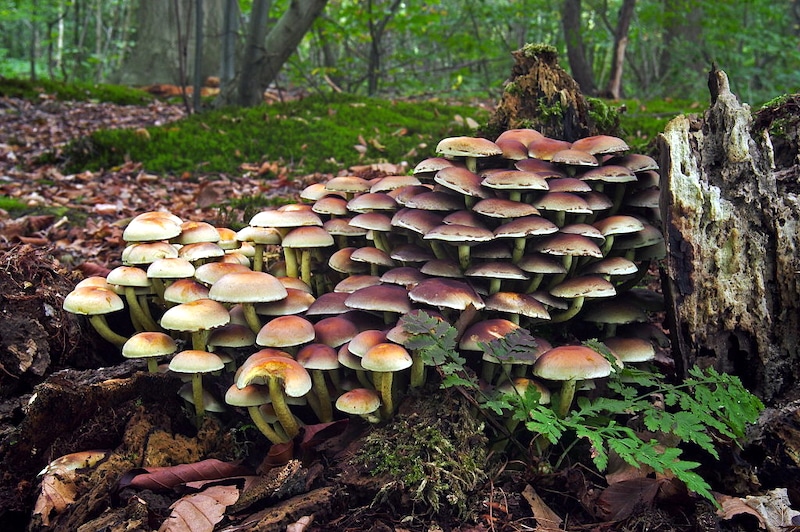This post was originally published on Eco Watch
The question of how intelligent plants and fungi are has been increasingly explored by scientists, as they have delved into the capability of these lifeforms to perceive and communicate with each other and the outside world.
A new study has found that fungi can not only perceive, but learn, have memories, solve problems and make decisions.
“You’d be surprised at just how much fungi are capable of,” said Yu Fukasawa, as assistant professor in the graduate school of agricultural science at Tohoku University, in a press release from Tohoku University. “They have memories, they learn, and they can make decisions. Quite frankly, the differences in how they solve problems compared to humans is mind-blowing.”
When you see mushrooms growing on the surface of soil, the small umbrella-like caps are really the fruiting bodies of an expansive underground mycelium below. The mycelium is an intricate and complex fungal network germinated and formed by spores. This subterranean web of long, spidery threads spreads underground like roots and is similar to the brain’s neural connections.
In the study, the researchers looked at how a mycelial network growing on decaying wood responded to two distinct situations: wood blocks arranged in a cross arrangement versus in a circle.
If the fungi did not have decision-making skills, they would spread out from the center without being affected by the placement of the blocks. However, this is not what happened.
“For the cross arrangement, the degree of connection was greater in the outermost four blocks. It was hypothesized that this was because the outermost blocks can serve as ‘outposts’ for the mycelial network to embark in foraging expeditions, therefore more dense connections were required,” the press release said. “In the circle arrangement, the degree of connection was the same at any given block. However, the dead center of the circle remained clear. It was proposed that the mycelial network did not see a benefit in overextending itself in an already well-populated area.”
But how were the fungi in the study able to perceive the blocks?
“Probably through touch and ‘taste,’ Fukasawa told EcoWatch in an email. “While contact certainly influences mycelial behavior, they likely need to ‘taste’ the wood blocks to recognize them as a resource. This ‘tasting’ could involve secreting enzymes to break down the wood surface (e.g., cellulose) and absorb the resulting low-molecular sugars (e.g., glucose). Additionally, fungi may also ‘smell’ the wood, meaning they can detect volatile chemicals released, which might either promote or inhibit mycelial growth.”
Fukasawa said the question of whether fungi have memories is “a poorly explored but fascinating topic.”
“There may be several mechanisms of fungal memory, with the longevity of the memory potentially depending on the specific mechanism. One possibility is cellular-level memory, based on organelle dynamics such as the cytoskeleton and aggregates of small vesicles (called Spitzenkörper), which may produce relatively short-term memory,” Fukasawa told EcoWatch. “Studies suggest that memory of growth direction at the hyphal tip could be maintained for at least the length of a 100 µm hyphal growth. However, if memory is stored through other mechanisms, such as epigenetic changes in cellular activity, it could last longer.”
The findings suggest that the network of mycelia could communicate information regarding its surroundings throughout the whole fungal network. The mycelium was also able to alter its direction of growth based on the shape of the blocks.
“Our comprehension of the mysterious world of fungi is limited, especially when compared to our knowledge of plants and animals. This research will help us better understand how biotic ecosystems function and how different types of cognition evolved in organisms,” the press release said.
Fukasawa told EcoWatch that, not only are fungi important to ecosystems, they also help mitigate climate change.
“The main known functions of fungi in ecosystems are categorized as decomposers, symbionts, and pathogens. These functions often overlap (i.e., a single fungal species can perform more than one function), and all are important to ecosystem processes. However, when we focus on mitigating climate change, their role as decomposers is undoubtedly the most significant,” Fukasawa explained. “Decomposer fungi break down plant carbon polymers into low-molecular-weight carbon compounds for energy, eventually releasing CO2 through respiration. Thus, decomposition is a process that releases CO2 into the atmosphere.”
Fukasawa said there are two different kinds of wood decomposition: white rot and brown rot. With white rot, the wood’s cellulose and lignin are broken down, and with brown rot, just the cellulose is broken down, while the lignin remains intact.
“These different types of decomposition can affect the amount of CO2 released during the process. Additionally, recent studies show that a diverse decomposer fungal community actually slows down wood decomposition, suggesting that higher diversity among decomposer fungi may reduce CO2 emissions from forest ecosystems,” Fukasawa told EcoWatch.
What can people do to better support fungal networks?
“I believe forest fragmentation is a significant issue. Networks of some fungi can spread over areas larger than 900 hectares across the forest floor. In such cases, forest fragmentation directly disrupts fungal networks,” Fukasawa said. “While fungi can spread through airborne spores, maintaining direct connections via mycelial networks is also crucial. Similar to plants and animals, creating green corridors between fragmented forests could help support fungal networks. This is important because fungal mycelial networks can transport a variety of materials and information, which may help improve locally degraded environments and enhance the overall functioning of the ecosystem.”
The study, “Spatial resource arrangement influences both network structures and activity of fungal mycelia: A form of pattern recognition?” was published in the journal Fungal Ecology.
The post ‘Mind-Blowing’: Study Shows Fungal Networks Can Solve Problems and Make Decisions appeared first on EcoWatch.





0 Comments